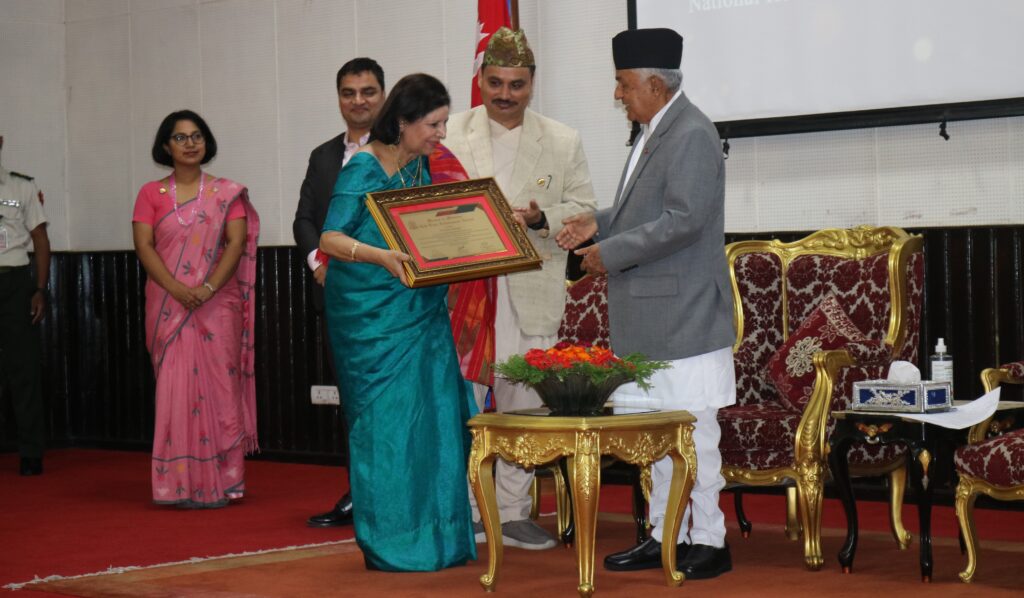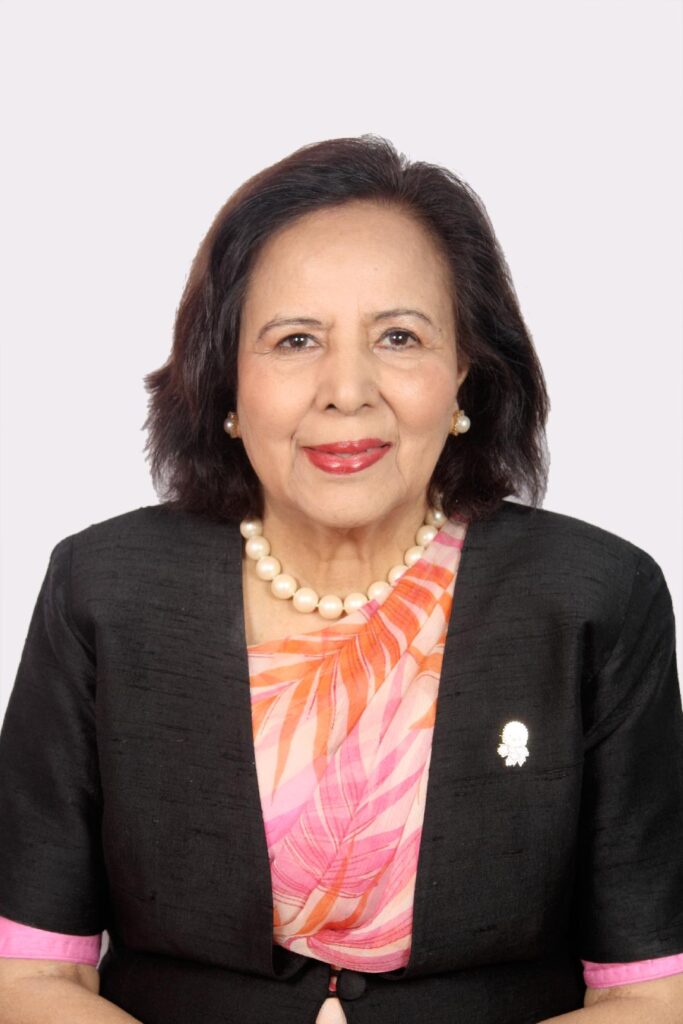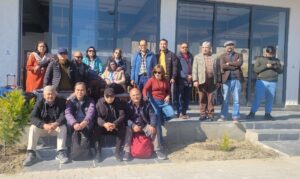First woman Rotarian of Nepal

Dr. Suniti Acharya, the first female Rotarian in Nepal, initially worked as a pediatrician at Kanti Children’s Hospital and also served as the Chief of the Health Policy, Health Planning, and Foreign Aid Division in the Ministry of Health in Nepal. She was a Regional Advisor at WHO’s South-East Asia Office for maternal, child, and reproductive health, as well as a Polio Commissioner and member of the Regional Commission on Polio Eradication. She has also served as the WHO Country Representative in Bangladesh. Dr. Acharya completed her MBBS in Agra, India, postgraduate pediatric training in the UK, and earned a diploma in child health in 1972. She later obtained a Master’s in Public Health from Tulane University, USA. Additionally, she is a past president of the Rotary Club of Jawalakhel.

Could you share the story of how you became the first female Rotarian in Nepal? What inspired you to join Rotary, and what challenges did you face in the early days?
At the request of members from the Inner Wheel Club of Kathmandu—Mrs. Soli Manikshaw, Mrs. Gulab Harjani, and Mrs. Mohan Devi Shrestha—I volunteered to run a weekly children’s clinic at Bhimsengola in Baneshwar, a busy area of Kathmandu. Every Saturday morning, I would check around 40 patients. Along with these three remarkable women, who dedicated three precious hours every weekend to running the clinic, I learned they raised the funds themselves and bought the medicines. I often wondered what motivated them to sacrifice their time, leaving their young children at home. Perhaps it was the Rotary motto, ‘Service Above Self,’ that inspired them, and their dedication left a lasting impression on my young, enthusiastic mind.
Another significant encounter with Rotary came in 1988, when Rotary International joined WHO in the Global Polio Eradication movement. As the Head of Nepal’s Polio Eradication Program at that time, I trained the first generation of Nepali Rotarians, who were mostly older businessmen. I admired how they spent hours in the classroom learning technical information about polio, which was challenging for them. I wondered why they chose to invest time in learning instead of focusing on their businesses. Now I realize it was likely the magic of Rotary’s motto, ‘Service Above Self,’ that also motivated them.
These two experiences sparked my deep interest and enthusiasm for Rotary, inspiring me to join at the first available opportunity.
During your childhood in Nepal, traditional barriers often prevented girls from attending school. Could you share more about your educational journey and how this experience influenced your personal and professional development? What were some key moments in your academic life that shaped who you are today?
As you rightly mentioned, traditional barriers were prevalent during my upbringing. In the 1950s, when I was growing up, the rigid belief among many parents was that there was no value in sending their daughters to school, as girls were expected to manage household duties, get married, and care for their husbands and children. However, my father, Sri Laxmi Nath Gautam, had a vastly different vision. He believed that girls should receive an education just like boys, to ensure a better future and professional competence.
At that time, girls from orthodox families did not attend school. My father hired home tutors for me, and I only began formal schooling in the ninth grade to prepare for the SLC exam. After passing the SLC, I attended Tri-Chandra College for my ISC and later went to India for medical school. Competing with Indian students, especially the boys, was extremely challenging. The teachers were strict, particularly toward female students. If a girl received low marks or failed, they would say, ‘If this is your performance, why did you come to medical school? You should have gotten married and stayed home.’ Such remarks frightened me but also motivated me to work even harder.
When I shared my struggles with my father, he encouraged me to be resilient and to push myself further. Looking back, the habit of working hard, sincerely, and with resilience became ingrained in my nature. This determination helped me climb the ladder of success, earning degrees from London and the USA, and eventually securing leadership positions in my professional career.
Given your pioneering role as the first female Rotarian in Nepal, how have you witnessed and addressed gender bias within Nepali society, particularly regarding educational opportunities for girls? What changes have you observed over the years, and what further progress do you believe is still needed?
There has been significant improvement in women’s lives over the past 30 years. Women’s access to formal education has a relatively short history in Nepal. Before 1950, education for women was virtually non-existent. In the 1950s, less than 1% of women were literate. In 1961, male literacy stood at 16%, while female literacy was just 1.76%. By 1971, male literacy rose to 22% and female literacy to 2.7%. In 2021, male literacy reached 89%, and female literacy increased to 69%—a remarkable improvement.
Census data shows that women now make up 30% of the civil service workforce, with nine women serving as secretaries of the government out of 22 positions. Additionally, 40% of doctors are women. The constitution guarantees 33% of parliamentary seats for women, and there are 14,416 female local representatives. In the economic sector, women comprise 36% of the workforce.
However, much work remains to be done to overcome the cultural, social, and economic barriers to gender equality and to achieve true gender parity in the country.
As Rotary celebrates September as ‘Basic Education and Literacy Month,’ could you highlight the significant contributions Rotary has made toward improving basic education in Nepal?
Education is one of the seven areas of Rotary Focus. Accordingly, almost all the 154 clubs are having some programme or other in support of education in Nepal. This has created synergistic effect with Government run programmes and has improved literacy significantly. In partnership with government particularly local government, we have been able to transform the lives of girls and other vulnerable children in many rural and remote communities. With Rotary’s TEACH initiative, we support Teachers, boost E learning, Rotary International District 3292 has organized many Basic Education and Literacy Introduction and Orientation Seminars. Individual clubs have supported scholarships to girls. in remote districts, constructed school buildings damaged by earth quakes. Constructed toilets for girls in schools along with incinerators for disposal of sanitary pads to reduce drop outs and promote secondary education specially for girls’
The Dr. Suniti and Gopal Acharya Trust Fund annually honors one female Rotarian and one non-Rotarian woman professional with a hundred thousand rupee award for vocational excellence. What was the vision behind establishing the Dr. Suniti and Gopal Acharya Trust Fund?
As the first female Rotarian and a professional, I felt it was important to create a mechanism that would inspire and encourage many women to excel both as Rotarians and as high-level professionals. The Dr. Suniti and Gopal Acharya Trust Fund was established with the goal of recognizing and encouraging professional women within Rotary for their contributions to their clubs and society. This recognition aims to reduce dropout rates and increase retention in Rotary clubs. Additionally, the trust seeks to honor professional women outside of Rotary for their societal contributions, with the hope that they will be inspired to join Rotary clubs and contribute socially as well.
As the Rotary Women Leadership Chair, what are your key goals? How do you plan to encourage and support more women in taking up leadership roles within Rotary?
Women had to carry out more than 6 decades of struggle and legal battle till 1989 when the Council on Legislation finally voted to admit women in Rotary Clubs. Response to this decision was overwhelming. By 1990. The women membership was 20,000. By 2023 R.I membership was over 1.4 million of which 23% I.e, around 277,000 are women and many hold leadership positions. So far Two RI presidents are women. The world of Rotary today is much different than in the earlier years
WLR is a Committee within Dist 3292 with membership of Rotarians who translate their passions of improving participation as well as leadership of women to achieve Diversity, Equity inclusion in Rotary Dist 3292. Our vision is to exemplify” Service Above self ” and our goal is to Improve women membership from 18% to 25 by 2026
What advice would you give to young women who aspire to take on leadership roles, whether in Rotary or other fields?
Leadership is the art of guiding, inspiring, and influencing individuals to achieve common goals and a shared vision. Effective leadership is a rich amalgamation of qualities such as integrity, vision, communication skills, adaptability, empathy, resilience, and a dedication to continuous learning. Young women should strive to develop these qualities and build confidence in themselves. They need to enhance their leadership skills, prepare to face challenges, and work alongside men in equal partnership.
Aside from the topics we’ve discussed, is there anything else you would like to share with us? Perhaps a personal story or message that you believe would inspire others? What advice would you give to younger people?
While I was the head of the WHO country office in Bangladesh, a Western journalist interviewed me and asked, “As a Hindu woman from an underdeveloped country, how did you achieve a leadership position in a prestigious, male-dominated organization like WHO in a Muslim country?” My response was that I competed against around 30 men and was selected based on my professional qualifications and competency. I believe that with competence, empathy, and confidence, you can reach any height.




